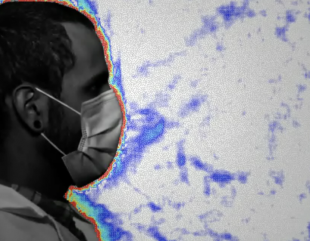We investigated the aerodynamics of droplets through the Maxey-Riley equation and we show that droplets with minimum horizontal range are from a few microns to a few hundred microns (Cummins et al. 2020). The result that such droplets have a very short range could have important implications for the interpretation of existing data on droplet dispersion.
In Viola et al (2020) we use a background oriented schlieren technique to investigate the air flow ejected by a person while breathing and coughing, the aerosol dispersion and the effectiveness of face covering in mitigating virus transmission risk. We found that all face covers without an outlet valve reduce the front flow through jet by more than 2/3. Surgical and hand-made masks, and face shields, generate several leakage jets, including intense backward and downwards jets that may present major hazards.
In Bandiera et al (2020), we study the effects of face coverings on mitigating dispersion of large respiratory tract droplet that land within seconds. These droplets are thought to be the main route to transmission of SARS-CoV-2 virus. We quantify the number of droplets in flight using laser sheet illumination and UV- light for those that had landed at table height at up to 2 m. We find that wearing a face covering decreases the number of projected droplets by more than 1000-fold. We estimate that a person standing 2 m from someone coughing without a mask is exposed to over 10,000 times more respiratory droplets than from someone standing 0.5 m away wearing a basic single layer mask. Our results indicate that face coverings show consistent efficacy at blocking respiratory droplets and thus provide an opportunity to moderate social distancing policies.




